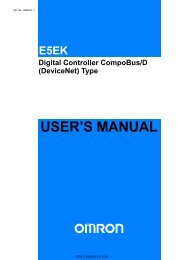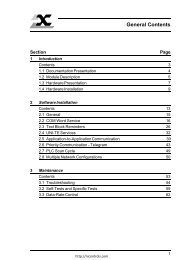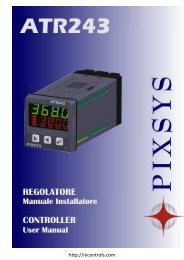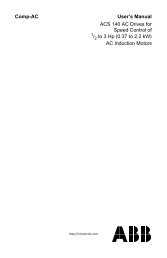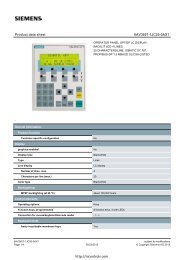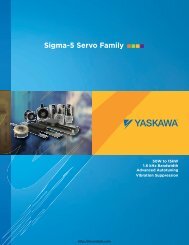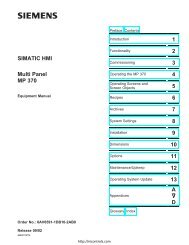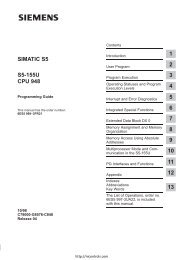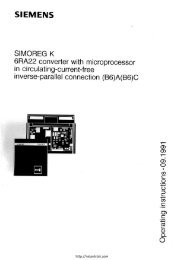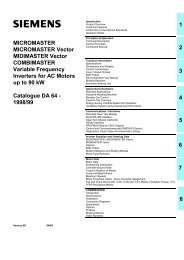Telemecanique Altivar 56 manual - Northern Industrial
Telemecanique Altivar 56 manual - Northern Industrial
Telemecanique Altivar 56 manual - Northern Industrial
Create successful ePaper yourself
Turn your PDF publications into a flip-book with our unique Google optimized e-Paper software.
Chapter 6 — Class 8839 ALTIVAR <strong>56</strong> Combination DevicesBulletin No. 50006-519-01BWiring December 1996Voltage ClassThe Voltage Class is used to categorize the voltages present into recognizedconductor insulation categories (30, 150, 300, and 600 V) for selection of conductorinsulation voltage rating and physical segregation purposes.Based upon the Noise Class and Voltage Class of the conductors, the wiringmethods in Table 47 should be applied to the drive system.Table 47: Wire Routing and InterconnectionWiring Methods and ConsiderationsNoise Class of Conductors [1]QW1 QW2 SW1 SW2 PW1Conductor Grouping in Wireways/Conduits1. All conductors of 1 or 3 phase AC power circuits must be bundled to minimizeX X Xstray magnetic fields.2. All conductors of a DC power circuit must be bundled to minimize stray magnetic fields. X X X3. When paralleled conductors must be run in separate wireways or conduit, bundle conductors intogroups that minimize stray magnetic fields.X X4. Maintain conductor runs as short and direct as practical. X X X X XSeparation of Circuits1. DO NOT run different Noise Class conductors in the same conduit.X X X X X2. DO NOT run different Voltage Class conductors in same conduit unless all conductors areinsulated for the maximum Voltage Class present.X X X X X3. All PW conductor groups must be individually segregated using metallic conduit. X4. Segregate all conductors by Noise Class. Use the following circuit separation when conductorscan run parallel for more than 12 inches.• Metallic conduit: 3 in between QW to SW/PW X X X X X• Metallic tray: 3 in between SW to PW X X X• Metallic tray: 6 in between QW to SW/PW X X X X X• Against continuous metal surface: 3 in between SW to PW X X X• Against continuous metal surface: 6 in between QW to SW/PW X X X X X• Metallic conduit housing QW: 12 in to non-metallic conduit SW/PW X X X X X• Non-metallic conduit: 3 in between SW to PW X X X• Non-metallic conduit: 24 in between QW to SW/PW X X X X X5. If QW and SW1 wiring must cross SW2 or PW1 wiring, the bundles must cross at right angles. X X X X XCommon Mode Noise Issues1. Provide adjacent signal returns using twisted pair cable.X X2. Galvanically isolate signal and associated signal return path when possible. X XShielding1. Use metallic conduit for all power and control circuits external to the controller enclosure.X X X X X2. Shields must be continuous and equipped with a drain wire. X X X3. DO NOT group different Noise Class conductors within the same shield. X X X X X4. Minimize non-shielded portion of conductor at the ends of shielded cable. X X X X X5. When shielding AC or DC power conductors, group conductors to minimizemagnetic field in shield.X X XGrounding1. Ground shields at one end only (the controller end).X X X X X2. Use separate ground wire for each shield ground. X X X X X3. Provide a ground wire with all conductor groups whether in tray or conduit. X X X4. When multiple grounds must be made to a shielded power cable, the shield must have the sameshort circuit withstand capability as the ground conductor in the power cable.X X X5. Terminate all power grounds and power shield grounds to the controller grounding point or bar. X X X6. Terminate all signal shield grounds to the terminals provided. X X7. Always supply a separate equipment grounding conductor with the controller power feed. DONOT depend upon metallic conduit for ground connection.X X X[1] Resolution limited to processor resolution.130 © 1996 Square D All Rights Reservedηττπ://νιχοντρολσ.χοm




